Workplace Bullying Statistics Research & Facts | Updated 2024
In the United States, the statistics show that 4 out of 10 employees suffer from some form of workplace bullying, defined as “repeated mistreatment of an employee by one or more other employees; abusive conduct that is threatening, humiliating or intimidating, workplace sabotage or verbal abuse”, which is still latent and cases are on the rise.
Workplace bullying is a topic that began to be talked about in the 1980s in Europe and arrived in the 1990s when psychologists Gary and Ruth Namie Ph.D.s initiated research in American territory, since then it has managed to focus on the prevention and identification of workplace bullying. If you want to dive more into the topic, we also covered the costs of bullying in the workplace.
In this article, you will find:
-> General Statistics on Bullying in the Workplace
-> Statistics on Bullying Awareness
-> Workplace Bullying in Remote Work
-> Types of Bullies by Strategies and Behaviors
-> Cyber Bullying in the Workplace
-> Main Victims
-> Consequences of Workplace Bullying
So, without further ado, here’s a roundup of the most newsworthy and jaw-dropping stats about bullying in the workplace.
Is your company offering jobs for people with disabilities? As an employer, you can publish your job offers on MyDisabilityJobs and reach thousands of qualified candidates.
Bullying in the workplace statistics (Editors Picks)
- The most recent data shows that 79.3 Million of U.S. workers are affected by workplace bullying.
- Men represent 67% of bullies while 33% are women.
- The bullies’ victim resignation rate is 23%
- Workplace bullying is considered the second leading cause of stress at work.
- The cost of bullying in the workplace goes up to $100,000 per year per victim.
- A 2016 study found that 8 out of 10 people have experienced cyberbullying in the workplace in the last six months.
- On average, 30% of workers suffer or have suffered from direct workplace bullying
- A survey conducted in 2019 found that nearly 94% of 2081 employees said they had been bullied in the workplace. That’s a large increase (19%) over the past eleven years.
- Managers and bosses represent 65% of the bullies
- The most common types of bullying are aggressive email tones (23.3%), negative gossip from co-workers (20.2%), and colleagues yelling at them (17.8%).
General statistics on workplace bullying
The most recent survey conducted in 2021 shows that, on average, 30% of workers suffer or have suffered from direct workplace bullying, but define those “affected” by bullying as those who have direct or indirect experiences with it, i.e. those who witness the harassment suffered by another colleague are considered indirect victims of bullying, making that among American workers:
- 30% suffer abusive behavior at work.
- 49% are affected.
- 66% know that workplace bullying occurs.
The research found that in witnesses of workplace bullying, emotional injuries were similar in severity to those suffered by people who were directly bullied, as it can be traumatic to see a colleague being humiliated and intimidated. This could increase the percentage of those affected by workplace bullying to 49%.
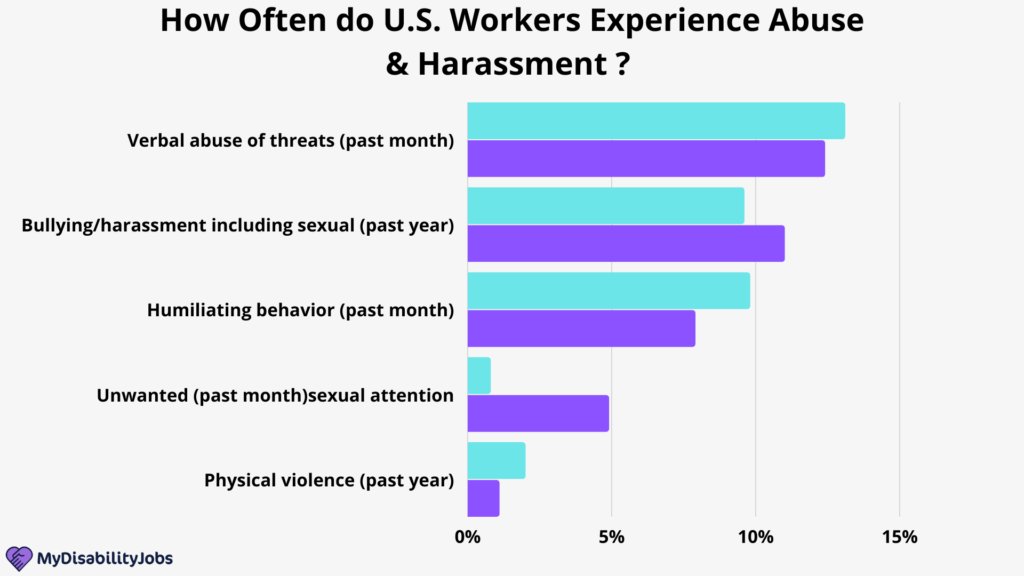
Here are the exact numbers:
| Type of Abuse | Men | Women |
|---|---|---|
| Verbal abuse or threats (past month) | 13.1% | 12.4% |
| Bullying/harassment including sexual (past year) | 9.6% | 11.0% |
| Humiliating behavior (past month) | 9.8% | 7.9% |
| Unwanted sexual attention (past month) | 0.8% | 4.9% |
| Physical violence (past year) | 2.0% | 1.1% |
Statistics on bullying awareness
But despite all the awareness campaigns about bullying and its potential consequences, many people say they don’t know what workplace bullying is all about – in fact, among Republican respondents to the Survey, 46% said they were unaware. In contrast, only 30% of Democratic respondents did not know. A similar pattern emerged when ideologies were compared. Of conservatives, 44% denied that bullying exists, while 26.7% of liberals did.
| Experience with Bullying | Conservative | Moderate | Liberal |
|---|---|---|---|
| Bullied Target | 28.5% | 20.9% | 44.2% |
| Witnessed | 14.1% | 20.3% | 23.9% |
| Bullies | 4.4% | 1.8% | 5.9% |
| Believers | 25.5% | 20% | 23.1% |
| Unaware | 44% | 45.4% | 26.7% |
- Groups “aware” of workplace bullying are 66%. That means that two-thirds of American adults are familiar with workplace bullying, ranging from painfully intimate immersion to superficial recognition of the term without knowing much.
- Workers who have experienced direct harassment numbered 48.6 million; witnesses total another 30.6 million. The sum suggests that 79.3 million workers have been affected (directly or indirectly).
- The number of Americans aware that workplace bullying exists is nearly double the number who deny it.
The following graph is a sample of that number by combining the population of the dozen states shaded in red (which actually total 79.3 million). Surprisingly, 4% of the Adult sample claimed to be perpetrators. Assuming underreporting, 6.6 million is a conservative estimate of the number of stalkers operating in organizations.
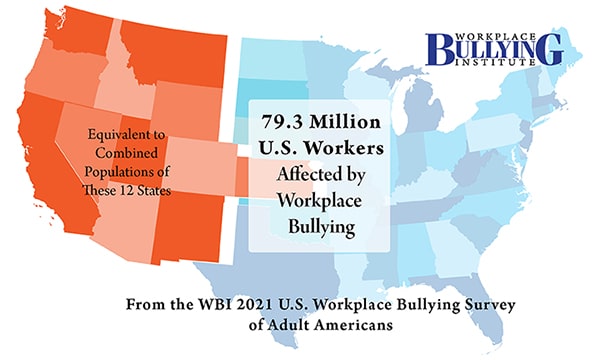
Sources: WBI Survey, RAND Corp.
Workplace bullying in remote work
With the rise of remote jobs, a window of opportunity opened for many to earn money from home, however, that does not stop workplace bullying, in fact, in 2021 the percentage of remote workers affected by bullying (direct or indirect) was reported to be 61.5%. The national rate was 49%, while the rate for the occupied sample respondents was 61%.
| Experience with Bullying | Remote | Hybrid | No Remote |
|---|---|---|---|
| Bullied Target | 43.2% | 17.4% | 20.6% |
| Witnessed | 18.3% | 29.3% | 15.8% |
| Bullies | 6.3% | 6.5% | 2.4% |
| Believers | 15.3% | 19.6% | 22.2% |
| Unaware | 16.9% | 27.2% | 39% |
- Bullying when working remotely is mostly seen in group meetings/video calls, where the victim is humiliated or treated in a derogatory manner.
- 15% of this harassment is done in private meetings between the bully and victim. 6% of the bullying is in group emails where the bully is denigrated in front of other peers and 3% in individual emails.
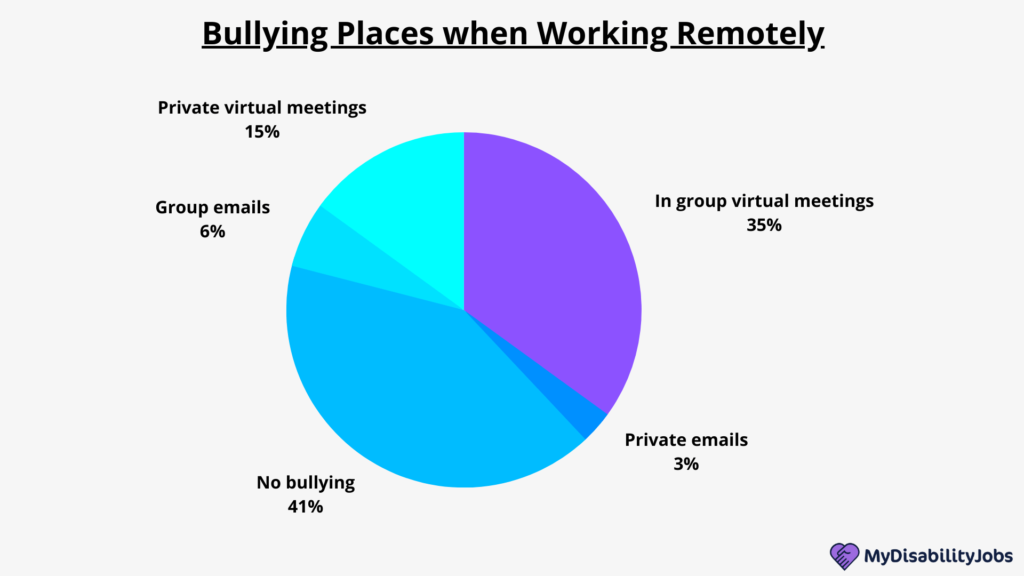
Sources: WBI Survey.
Profile of bullies
- To date, bosses continue to be the most frequent perpetrators.
- Bullying among peers of the same rank occurs in approximately 1 in 5 cases.
- Lower-ranking subordinates bully superiors in 14% of cases.

The following results were obtained by analyzing the gender of the victims and perpetrators:
| Gender Pairs – Adults | Percentage |
|---|---|
| Malte perpetrator: Male target | 40% |
| Male perpetrator: Female target | 28% |
| Male Perpetrator | 67% |
| Female perpetrator: Male target | 11% |
| Female perpetrator: Female target | 21% |
| Female perpetrator | 33% |
| Same Gender Pairs | 61% |
| Male Target | 51% |
| Female Target | 49% |
- This shows that men represent 67% of bullies while 33% are women.

Types of bullies by strategies and behaviors
It has also been possible to identify different types of bullies according to their strategies and aggressive behavior. This is key to detecting certain forms of bullying that do not usually go unnoticed and knowing what to do about each of them.
- The prankster: Like the class clown in high school, this person plays jokes on co-workers. Sure, some office gags are perfectly innocent, but there’s a line between playing a harmless prank and intentionally humiliating someone.
- The jerk: Some people, like the jerk, are simply mean by nature. This person brings a toxic attitude to the office environment by delivering angry or condescending remarks to their co-workers.
- The saboteur: This type of person tries to undermine every move of his or her co-worker and prevent them from succeeding at their job.
- The critic: This person, typically in a management position, talks down to direct reports and picks apart your work.
- The gossip: Gossiping was a frequently cited form of bullying in the Monster poll (20%). It can really take a toll on workers’ job performance as well as tarnish their reputation.
- The gatekeeper: Taking a more indirect approach, this person withholds resources that you need to succeed (e.g., a boss who does not provide you with adequate time to complete a project).
Sources: Monster survey, WBI Survey.
Cyberbullying in the workplace
Most people consider cyberbullying a teenage issue. However, the workplace is not immune to cyber bullying as the problem has expanded to adults, especially in the last few years. Due to the Covid-19 pandemic, many companies migrated their jobs to an online atmosphere, leading to more cases of cyberbullying at work.
The use of technology and the blurring of our work and home life means that the harassment does not necessarily only occur during working hours, and does not necessarily end when the individual leaves work. This creates a particular form of bullying to be aware of.
In comparison to workplace bullying, cyberbullying can potentially be easier for employers to investigate but also can often take a more subtle form. Also compared with youth-based cyberbullying, cyberbullying at work involves more risk, because if discovered the perpetrator could be reprimanded or even dismissed.
Unfortunately, not enough research has been done regarding workplace cyberbullying, but some data is available:
- A 2005 study found that bullying via email was associated with an intention to leave the organization, lower job satisfaction, and anxiety.
- A 2009 research showed that 34% of employees surveyed were bullied face-to-face while 10.7% were cyberbullied.
- A 2016 study found that 8 out of 10 people have experienced cyberbullying in the workplace in the last six months.
- 14% to 20% of people felt they had been a victim of cyberbullying in the past week.
Sources: Farrer, CyberSmile, Queensland University, Journal of Human Resource Management
Main victims by ethnicity
- In terms of worker ethnicity Hispanics were the group most aware of the phenomenon of workplace bullying (80%) and also the most victimized by it. They are also witnessing it and more than a quarter of respondents believe it happens.

- For Asians, the rate of bullying (12%) reported is less than half the rate for African Americans.
- It should be noted that for Asians, a cultural stigma accompanies the admission that one is bullied, whereas it is acceptable to state that it is happening to others (who may be of a different racial group) and to believe in its existence.
Sources: WBI Survey
Consequences of workplace bullying
- Workplace bullying leads to consequences for both the victim (T in the graph) which can range from forced dismissals, job changes, and resignations, or for the perpetrator (P in the graph) such as punishments, or dismissals.
- The victim resignation rate of 23% in 2021 has increased from 2% in 2003 to 11% in 2010 to its current level.
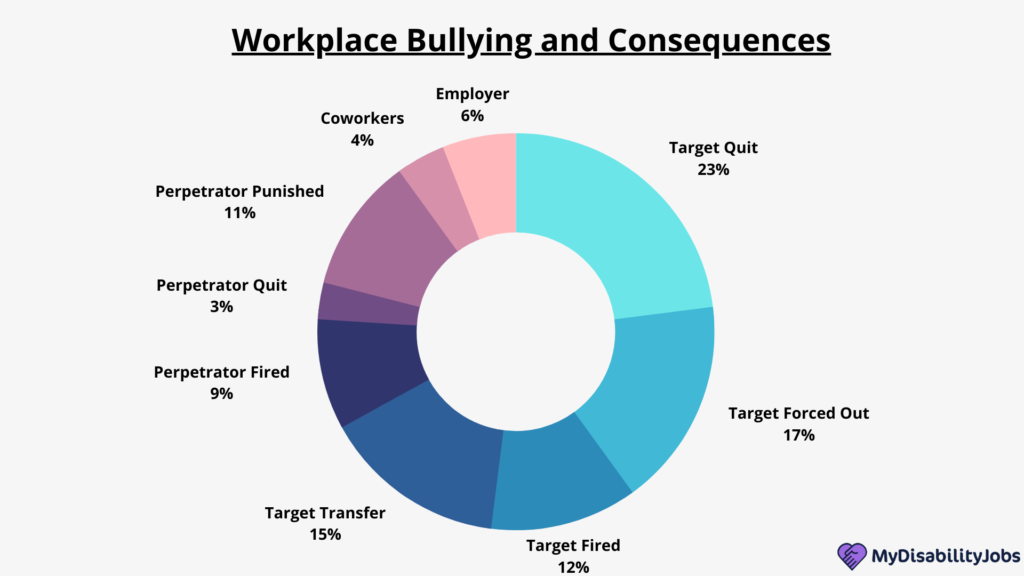
- This problem can have individual, social and organizational consequences.
- In terms of the social and family environment, there are tensions and conflicts, withdrawal of the victim from family members, abandonment of social ties (friends or partner), social stigmatization, social isolation, and social maladjustment, among other consequences.
- At the organizational level, the main consequences are reduced productivity, commitment, and motivation, absenteeism due to illness, job dissatisfaction, higher staff turnover, desire to leave their jobs, higher production costs, and forced reduction of working hours.
- In fact, workplace bullying is considered the second leading cause of stress at work.
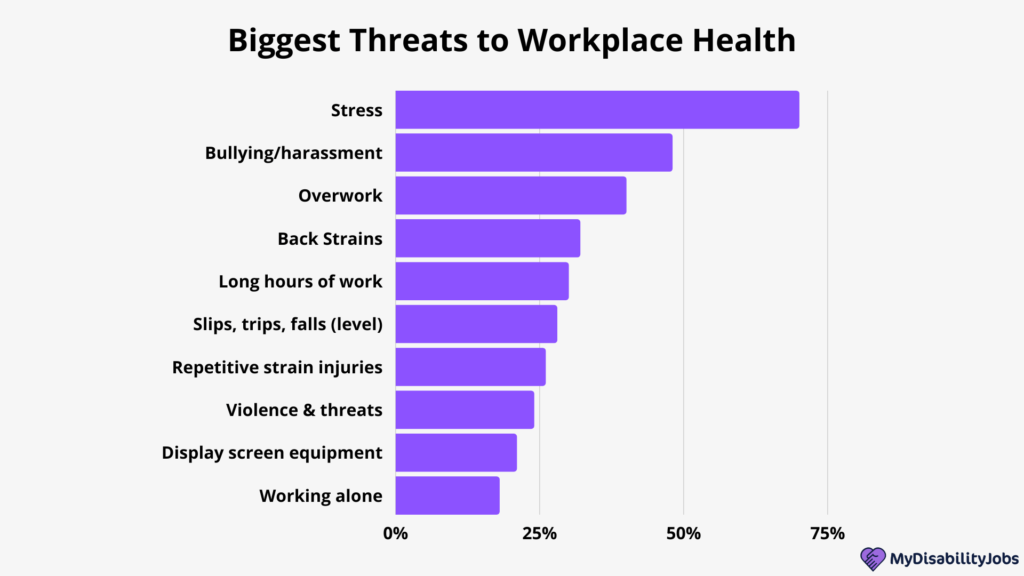
Sources: WBI Survey, TUC.
Is your company offering jobs for people with disabilities? As an employer, you can publish your job offers on MyDisabilityJobs and reach thousands of qualified candidates.
Conclusions and takeaways
There is still a lot of research and outreach to be done on the subject, but more and more people are becoming aware of workplace bullying and more are standing up against it. We have a long way to go, but we are seeing a change.
It is very important to be aware of the forms of bullying, knowing how to identify it means being able to fight it. It is also crucial to be able to react appropriately to this situation. Know the procedures and company policies on this matter to request timely assistance when bullying occurs. Most policies involve reporting to supervisors and Human Resources.
It is also essential to note that some industries may be more prone to workplace bullying than others. In these cases, find out about groups or organizations in your area and industry that can provide support.
FAQ
In the United States, it is estimated that 4 out of 10 employees suffer from some form of workplace bullying. That’s 79.3 Millions of U.S. workers who are affected by workplace bullying.
Bullying in the workplace is defined as repeated mistreatment of an employee by one or more other employees; abusive conduct that is threatening, humiliating or intimidating, workplace sabotage or verbal abuse.
Create a clear policy against workplace bullying and make sure employees are aware of it.
Foster a culture of respect and open communication in the workplace.
Respond promptly and confidentially to any reports of bullying.
Provide support and resources to employees who have experienced bullying.
Lead by example and demonstrate the professional behavior you expect from others.
Related articles
Statistics on Employees Burnout in the Workplace
Statistics of Diversity in the Workplace
Mental Health and Employment Statistics
Intellectual Disability Employment Statistics
Autism and Employment Statistics
Disability and Depression Statistics
Neurodiversity in the Workplace : Statistics


leave your comment